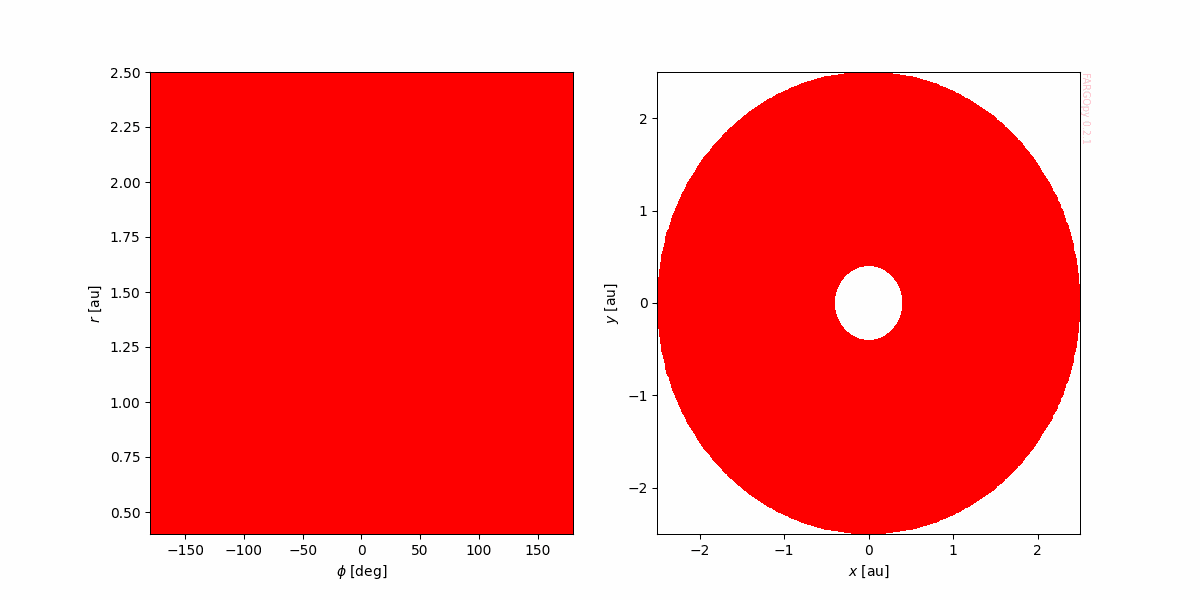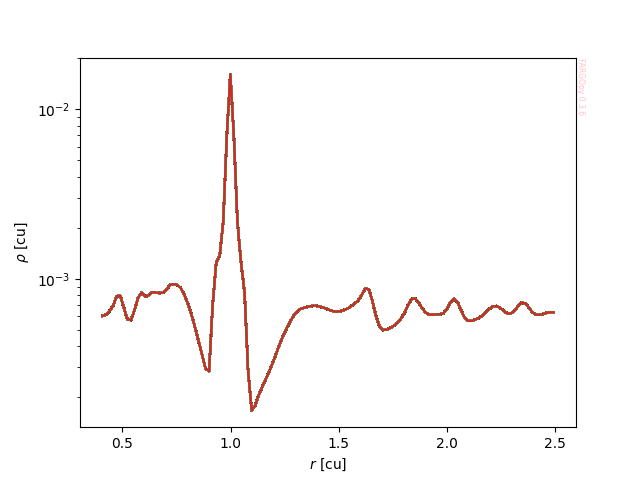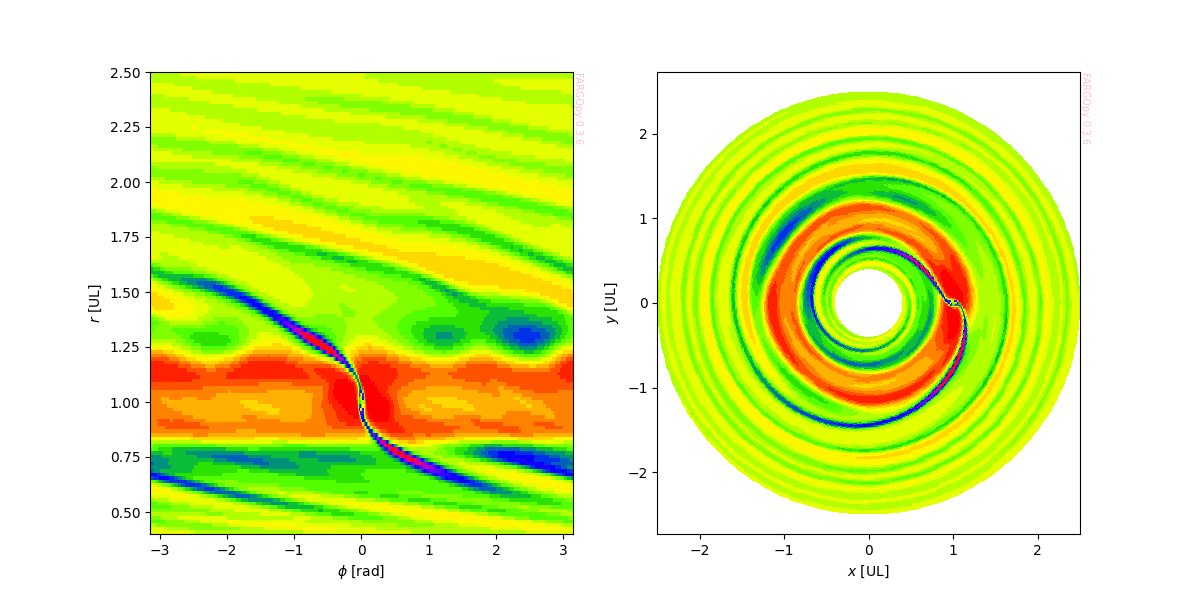FARGO3D Wrapping
Project description
FARGOpy
Wrapping FRAGO3D
FARGOpy is a python wrapping for FARGO3D, the well-knwon hydrodynamics and magnetohydrodynamics parallel code. This wrapping is intended to facillitate the interaction with FARGO3D, especially for those starting using the code. FARGOpy may be also useful for teaching and training purposes. For advanced users, FARGOpy provides useful functionalities in the postprocessing of simulation results, derivative calculations and plots.
This is an animation created with a few lines of code using FARGOpy (for the code and other examples see this tutorial):
Installing FARGOpy
FARGOpy is available at the Python package index and can be installed using:
$ pip install fargopy
as usual this command will install all dependencies (excluding FARGO3D which must be installed indepently as explained before) and download some useful data, scripts and constants.
Since FARGOpy is a python wrap for FARGO3D the ideal environment to work with the package is IPython/Jupyter. It works really fine in Google Colab ensuing training and demonstration purposes. This README, for instance, can be ran in Google Colab

If you are running in colab use:
#!pip install -Uq fargopy
If you are working in Jupyter or in Google Colab, the configuration directory and its content will be crated the first time you import the package:
import fargopy as fp
# These lines are intented for developing purposes; drop them in your code
%load_ext autoreload
%autoreload 2
Running FARGOpy version 0.3.2
If you are working on a remote Linux server, it is better to run the package using IPython. For this purpose, after installation, FARGOpy provides a special initialization command:
$ ifargopy
The first time you run this script, it will create a configuration directory ~/.fargopy (with ~ the abbreviation for the home directory). This directory contains a set of basic configuration variables which are stored in the file ~/.fargopy/fargopyrc. You may change this file if you want to customize the installation. The configuration directory also contains the IPython initialization script ~/.fargopy/ifargopy.py.
Downloading and installing FARGO3D
It is important to understand that FARGO3D works especially well on Linux plaforms (including MacOS). The same condition applies for FARGOpy. Because of that, most of the internal as well as the public features of the packages are designed to work in a Linux environment. For working in other operating systems, especially on MS Windows, please consider using virtual machines ow WSL.
Being an independent project, FARGOpy is not provided with a working version of FARGO3D. You need to download the C package and their prerequisites (compilers, third-party libraries, etc.) and configure them, by yourself. For a detailed guide please see the FARGO3D documentation or the project repo at bitbucket.
Still FARGOpy provides a simple way to get the latest version of the source code of FARGO3D from its public GitHub repository. The source code will be downloaded into the home directory and stored as ~/fargo3d/.
WARNING: If you want to change the final location of the source code or the name of the
FARGO3Ddirectory, before executing the following command, please change the corresponding configuration variables in~/.fargopy/fargopyrc
To download the FARGO3D source code execute:
fp.initialize('download',force=True)
Downloading FARGOpy...
Directory '/home/jzuluaga/fargo3d/' already exists. Removing it...
Cloning into 'fargo3d'...
FARGO3D downloaded to /home/jzuluaga/fargo3d/
Header file for FARGO3D found in the fargo directory /home/jzuluaga/fargo3d/
Once download it you may check if the source code is compiling in your machine. For that purpose run:
fp.initialize('check',regular=1,gpu=0,parallel=0)
Test compilation of FARGO3D
Checking normal compilation.
Running 'make -C /home/jzuluaga/fargo3d/ clean mrproper all PARALLEL=0 GPU=0 2>&1 |tee /tmp/fargo_regular.log':
Compilation in mode regular successful.
Skipping gpu compilation
Skipping parallel compilation
Summary of compilation modes:
Regular: 1
GPU: 0
Parallel: 0
If you have some error at compiling FARGO3D in some of the possible modes (regular, gpu and/or parallel) please check the corresponding logfile and correct the problems. Compiling problems will normally arise because of a lacking of an important dependency, for instance a compiler, a driver (in the case of GPU) or a third-party library or tool (eg. openmpi).
Quickstart
Here we will illustrate the minimal commands you may run to test the package. A more detailed set of examples can be found in this tutorial. In depth examples are available in the examples directory of the GitHub repository.
There are two complimentary modes when using FARGOpy:
-
Control mode: Using this mode you can run and control
FARGO3Dfrom your notebook. This mode requires a working copy ofFARGO3Dready to be compiled and run. This mode is ideal for training or testing purposes. -
Postprocessing mode: Using
FARGOpyin this mode allows you to process some of the output files produced by aFARGO3Dsimulation. This mode does not necesarily requires that a working copy ofFARGO3Dbe installed in the machine where you are performing the postprocessing analysis. This mode is ideal for advanced users.
Control mode
Create a simulation:
sim = fp.Simulation(setup='fargo')
Your simulation is now connected with '/home/jzuluaga/fargo3d/'
Now your simulation setup is at '/home/jzuluaga/fargo3d/setups/fargo'
Compile the FARGO3D binary to run the simulation:
sim.compile(parallel=0,gpu=0)
Compiling fargo3d_SETUP-fargo_PARALLEL-0_GPU-0...
Succesful compilation of FARGO3D binary fargo3d_SETUP-fargo_PARALLEL-0_GPU-0
Run the simulation:
sim.run(cleanrun=True)
No output directory /home/jzuluaga/fargo3d/outputs/fargo yet created.
Running asynchronously (test = False): ./fargo3d_SETUP-fargo_PARALLEL-0_GPU-0 -m -t setups/fargo/fargo.par
Now you are connected with output directory '/home/jzuluaga/fargo3d/outputs/fargo'
You may check the status:
sim.status()
################################################################################
Running status of the process:
The process is running.
Or check the progress of the simulation:
sim.status('progress')
Progress of the simulation (numstatus = 5):
1:OUTPUTS 2 at date t = 12.566371 OK [output pace = 0.1 secs]
2:OUTPUTS 3 at date t = 18.849556 OK [output pace = 0.1 secs]
3:OUTPUTS 4 at date t = 25.132741 OK [output pace = 0.7 secs]
################################################################################
Running status of the process:
The process is running.
You may stop the simulation at any time using:
sim.stop()
Stopping FARGO3D process (pid = 24648)
Check the status of the simulation using:
sim.status('summary')
The simulation has been ran for 7 time-steps (including the initial one).
Once stopped you may resume the simulation at any snapshot or at the latest resumable snapshot:
sim.resume()
Resuming from snapshot 5...
Running asynchronously (test = False): ./fargo3d_SETUP-fargo_PARALLEL-0_GPU-0 -m -t -S 5 -t setups/fargo/fargo.par
Now you are connected with output directory '/home/jzuluaga/fargo3d/outputs/fargo'
Once the simulation has been completed you will notice by ran:
sim.status()
################################################################################
Running status of the process:
The process has ended with termination code 0.
Postprocessing mode
Now that you have some results to process, it is time to use the functionalities that FARGOpy provides for this purpose.
Create the simulation and connect it to the output directory:
sim = fp.Simulation(output_dir = '/home/jzuluaga/fargo3d/outputs/fargo')
Your simulation is now connected with '/home/jzuluaga/fargo3d/'
Now you are connected with output directory '/home/jzuluaga/fargo3d/outputs/fargo'
Load the properties of the simulation:
sim.load_properties()
Loading variables
84 variables loaded
Simulation in 2 dimensions
Loading domain in cylindrical coordinates:
Variable phi: 384 [[0, -3.1334114227210694], [-1, 3.1334114227210694]]
Variable r: 128 [[0, 0.408203125], [-1, 2.491796875]]
Variable z: 1 [[0, 0.0], [-1, 0.0]]
Number of snapshots in output directory: 51
Configuration variables and domains load into the object. See e.g. <sim>.vars
Load gas density field from a given snapshot:
gasdens = sim.load_field('gasdens',snapshot=20)
Create a meshslice of the field:
gasdens_r, mesh = gasdens.meshslice(slice='z=0,phi=0')
Plot the slice:
import matplotlib.pyplot as plt
plt.ioff() # Drop this out of this tutorial
fig,ax = plt.subplots()
ax.semilogy(mesh.r,gasdens_r)
ax.set_xlabel(r"$r$ [cu]")
ax.set_ylabel(r"$\rho$ [cu]")
fp.Util.fargopy_mark(ax)
fig.savefig('gallery/example-dens_r.png') # Drop this out of this tutorial
You may also create a 2-dimensional meshslice:
gasdens_plane, mesh = gasdens.meshslice(slice='z=0')
And plot it:
plt.ioff() # Drop this out of this tutorial
fig,axs = plt.subplots(1,2,figsize=(12,6))
ax = axs[0]
ax.pcolormesh(mesh.phi,mesh.r,gasdens_plane,cmap='prism')
ax.set_xlabel('$\phi$ [rad]')
ax.set_ylabel('$r$ [UL]')
fp.Util.fargopy_mark(ax)
ax = axs[1]
ax.pcolormesh(mesh.x,mesh.y,gasdens_plane,cmap='prism')
ax.set_xlabel('$x$ [UL]')
ax.set_ylabel('$y$ [UL]')
fp.Util.fargopy_mark(ax)
ax.axis('equal')
fig.savefig('gallery/example-dens_disk.png') # Drop this out of this tutorial
Working with precomputed simulations
If you don't have the resources to compile or run FARGO3D and still you want to test the postprocessing functionalities of the package you may download a precomputed simulation:
fp.Simulation.download_precomputed(setup='fargo')
Downloading fargo.tgz from cloud (compressed size around 55 MB) into /tmp
Downloading...
From: https://docs.google.com/uc?export=download&id=1YXLKlf9fCGHgLej2fSOHgStD05uFB2C3
To: /tmp/fargo.tgz
100%|██████████| 54.7M/54.7M [00:01<00:00, 31.2MB/s]
Uncompressing fargo.tgz into /tmp/fargo
Done.
We have prepared a set of precomputed simulations covering some interesting scientific cases. You may see the list of precomputed simulations available in the FARGOpy cloud repository:
fp.Simulation.list_precomputed()
fargo:
Description: Protoplanetary disk with a Jovian planet in 2D
Size: 55 MB
p3diso:
Description: Protoplanetary disk with a Super earth planet in 3D
Size: 220 MB
p3disof:
Description: Protoplanetary disk with a a Super earth planet in 3D (increased resolution)
Size: 440 MB
fargo_multifluid:
Description: Protoplanetary disk with several fluids (dust) and a Jovian planet in 2D
Size: 100 MB
binary:
Description: Disk around a binary with the properties of Kepler-38 in 2D
Size: 140 MB
You may find in the examples directory of the GitHub repository, example notebooks illustrating how to use FARGOpy for processing the output of this precomputed simulations.
What's new
Version 0.3.*:
- Refactoring of initializing routines.
- Improvements in documentation of basic classes in
__init__.py. - Precomputed simulations uploaded to FARGOpy Cloud Repository and available usnig
download_precomputedstatic method.
Version 0.2.*:
- First real applications tested with FARGOpy.
- All basic routines for reading output created.
- Major refactoring.
Version 0.1.*:
- Package is now provided with a script 'ifargopy' to run 'ipython' with fargopy initialized.
- A new 'progress' mode has been added to status method.
- All the dynamics of loading/compiling/running/stoppìng/resuming FARGO3D has been developed.
Version 0.0.*:
- First classes created.
- The project is started!
This package has been designed and written mostly by Jorge I. Zuluaga with advising and contributions by Matías Montesinos (C) 2023
Project details
Release history Release notifications | RSS feed
Download files
Download the file for your platform. If you're not sure which to choose, learn more about installing packages.
Source Distribution
Built Distribution
File details
Details for the file fargopy-0.3.3.tar.gz.
File metadata
- Download URL: fargopy-0.3.3.tar.gz
- Upload date:
- Size: 27.2 kB
- Tags: Source
- Uploaded using Trusted Publishing? No
- Uploaded via: twine/4.0.2 CPython/3.10.12
File hashes
| Algorithm | Hash digest | |
|---|---|---|
| SHA256 | ff112e0dbe6e33b0cc9f9c2f9161049cc391866914b33f4ec9815fceaff0dd4b |
|
| MD5 | f8d31baf4a9bf7698269b87a52cb0095 |
|
| BLAKE2b-256 | e30889c58b71e9b5858eab119c3e0898f4a32833b86617ae0459430157b537c7 |
File details
Details for the file fargopy-0.3.3-py3-none-any.whl.
File metadata
- Download URL: fargopy-0.3.3-py3-none-any.whl
- Upload date:
- Size: 24.2 kB
- Tags: Python 3
- Uploaded using Trusted Publishing? No
- Uploaded via: twine/4.0.2 CPython/3.10.12
File hashes
| Algorithm | Hash digest | |
|---|---|---|
| SHA256 | d24f51645cf2aa9b20348afbf383195e6460961da7e017c46fb73a19d7dd1464 |
|
| MD5 | ccdb306bf1e0f6ab0b4c5903bde00962 |
|
| BLAKE2b-256 | a86e86d090f30f2522160557791b35a3a586102d7522557b4949ec24086cb75f |
















